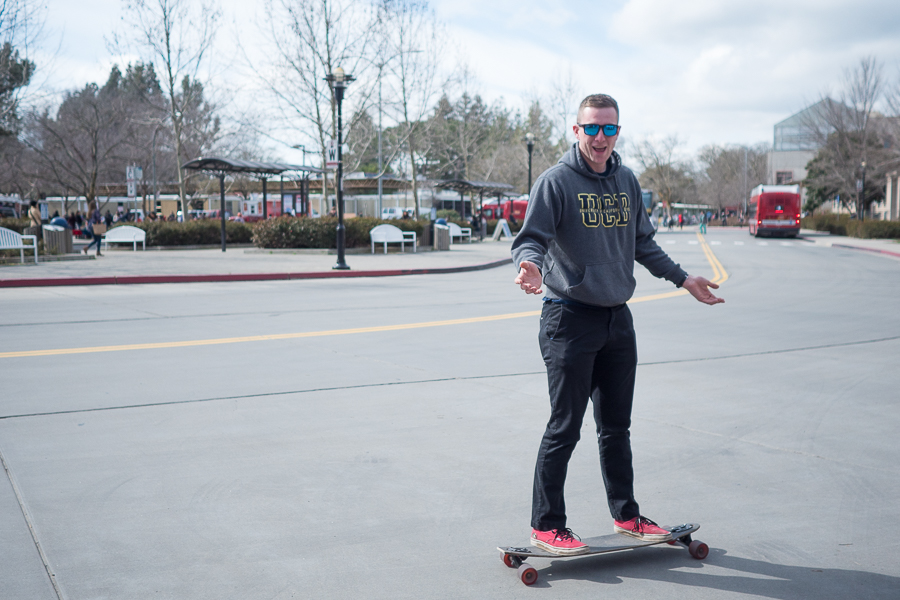
Students chose unique forms of transportation to navigate campus
The UC Davis campus has 8.3 square miles of extended campus. With only 10 minutes between classes, walking — or running — is not always the best option. Many UC Davis students and faculty members have taken to biking as their main mode of transportation, but there is a population of students who choose to use alternative vehicles that work better for their lifestyles.
“I got the idea [to scooter] from one of my professors,” said Kristoffer Landes, a fourth-year linguistics major. “[Professor] Patrick Farrell always rides his scooter to and from class.”
For Landes, a scooter is more convenient than having a bike.
“Compared to a bike, you can fold [a scooter] up and carry it with you wherever you go,” Landes said. “Because I commute back and forth to campus everyday, having a bike really wasn’t a great option — I didn’t want to leave something chained up overnight. [I] don’t really ever have to worry about it ever being stolen, […and it] is obviously faster than walking.”
Even when not commuting to campus, students find that an alternative form of transportation is less hassle than a bike. Elliot Odisho, a third-year economics major, uses a longboard to get around.
“I don’t like the whole process [where] you have to register [your bike],” Odisho said. “I just don’t want to do that, and […] I don’t like the fact that I have to lock it up and […] find bike parking. I know there is a lot [of bike parking] but […] with [a longboard] I can just bring it inside whatever class I go to and just put it up against the wall and not worry about it.”
According to Crane Sun, a fourth-year food science major, choosing an alternative form of transportation can save students some time during the day. Like Odisho, Sun likes to ride his longboard to class.
“I did bike for a period of time,” Sun said. “I just felt like a longboard was more convenient in terms of just finding bike parking, buying locks and maintenance. That’s pretty much why I longboard.”
Sun explained that these students who have chosen a form of transportation other than a bike still try to abide by the same rules of the road.
“I tend to be more […in] the middle of one lane [when I longboard],” Sun said. “Bikes could just simply go around me if they need to make a left or right turn. Normally I just do typical hand signals for bikes […] so people know where I’m going. I haven’t had any issues with bikers before just because I’m […] too slow to be an issue but, like, if I was speeding on my longboard — which is relatively hard to do or very rare — that’s another thing.”
Similar to Sun, Odisho finds that the downside to longboarding is its speed in comparison to that of a bicycle.
“Honestly, the cons [are] you don’t go as fast [as a bike],” Odisho said. “The amount of energy exuded over time [when biking], I feel like it’s more efficient to bike places. You can take [a longboard] in your car [or] on the bus […] so it’s always with you [and] you don’t have to worry about it getting stolen.”
While the pavement is not as big of a problem for bikers, it poses a threat to the safety of students who use other modes of transportation, especially for students who choose to longboard. Odisho and Sun both reported a safety issue with uneven pavement near the Silo.
“I only had one accident, and it was at night,” Sun said. “By the Silo […] there used to be this giant pothole. I didn’t really see it clearly, and I kind of just […] hit the pothole and flew forward a bit and hit the pavement.”
Rough as the surface may have been, Sun popped back up with only minor injuries.
“I was like ‘ow,’” Sun said. “I mean, it hurt a little bit. It wasn’t too bad.”
According to Odisho, uneven pavement is more dangerous to those who scooter or longboard than those who bike.
“There was one time [I crashed] over by the Silo,” Odisho said. “The thing with longboard wheels is they are solid, and there is no air in them. Unlike bike tires, there’s […] no [air] cushion, so it’s really easy to get caught up in cracks. One of the wheels got caught up in the crack and I just kind of ate it. It’s just bad luck there.”
With no major injuries to report, Sun and Odisho continue to longboard to and from their classes.
Students like Sun, Odisho and Landes find that these alternative forms of transportation are more convenient for their needs. According to Landes, sharing the bike-filled roads at UC Davis has not been a problem for him and shouldn’t for other students who are interested in leaving the bike at home.
“You can get on the roads with the other bikes,” Landes said. “People just seem to realize you’re another person using a different mode of transportation and they kind of give you your space.”
Written by: Elizabeth Marin — features@theaggie.org



